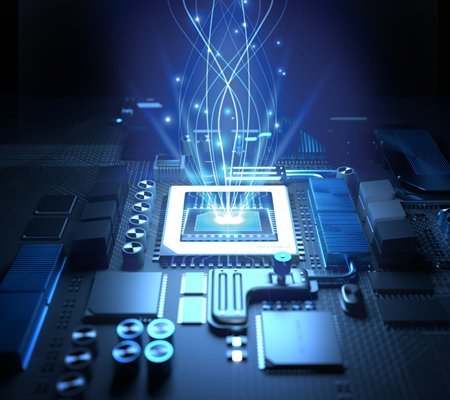Home - Solutions
Very-large-scale integration (VLSI) is a process of combining thousands of transistors into a single chip. It started in the 1970s with the development of complex semiconductor and communication technologies.
A VLSI device commonly known is the microcontroller. Before VLSI, most ICs had limited functions. An electronic circuit usually consists of a CPU, ROM, RAM and other peripherals on one board. VLSI lets IC designers add all of these into one chip. Let’s look into the back-story of VLSI development before going into specifics.
Integrated circuit through the yearsThe first integrated circuits contained only a few transistors. Early digital circuits containing transistors in tens, provided a few logic gates and early ICs had as few as two transistors. The number of transistors in an IC has increased dramatically since then.

| Name | Year | Transistors number | Logic gates number |
|---|---|---|---|
| small-scale integration (SSI) | 1964 | 1 to 10 | 1 to 12 |
| medium-scale integration (MSI) | 1968 | 10 to 500 | 13 to 99 |
| large-scale integration (LSI) | 1971 | 500 to 20,000 | 100 to 9,999 |
| very large scale integration (VLSI) | 1980 | 20,000 to 1,000,000 | 10,000 to 99,999 |
| Ultra large scale integration (ULSI) | 1984 | 1,000,000 and more | 100,000 and more |
The increase in density happens through multiple developments. Some of which would be a reduction in size, management in power consumption among others,
The design of a VLSI IC consists broadly of 2 parts. Front end design includes digital design using HDLs such as Verilog, VHDL, System Verilog and the like. It includes design verification through simulation and other verification techniques. The process includes designing, starting from gates to design for testability. Backend design comprises of CMOS library design and its characterization. It also covers physical design and fault simulation. The entire design procedure follows a step by step approach. The front end design steps would involve,
Problem SpecificationIt is a high-level representation of the system. The major parameters are performance, functionality, physical dimensions, fabrication technology and design techniques. It has to be a tradeoff between market requirements, the available technology and the economic viability of the design. The end specifications include the size, speed, power and functionality of the VLSI system.
Architecture DefinitionBasic specifications like floating point units, which system to use, like reduced instruction set computer (RISC) or complex instruction set computer (CISC), number of ALU’s cache size etc.
Functional DesignDefines the major functional units of the system and hence facilitates the identification of interconnect requirements between units, the physical and electrical specifications of each unit.
Logic DesignBoolean expressions, control flow, word width, register allocation etc. are developed and the outcome is the register transfer level (RTL) description. HDLs implement the RTL description onto a system.
Circuit DesignWhile the logic design gives the simplified implementation of the logic, the realization of the circuit in the form of a net list is done in this step. The net list consists of gates, transistors and various interconnect. This again is a software step and the outcome is checked via simulation.
Physical DesignThe conversion of the net list into its geometrical representation is done in this step and the result is called a layout. This step follows some predefined fixed rules like the lambda rules which provide the exact details of the size, ratio and spacing between components.
Back end hardware developmentNext, we have the hardware implementation (or what we study in college). Once we sort out the issues with hardware in a simulated environment, we move onto the actual hardware. Majorly talking, we have the following steps in hardware fabrication,
Wafer processingPure silicon is melted in a pot at 1400º C. A small seed containing the desired crystal orientation is inserted into molten silicon and slowly (1mm/minute) pulled out. The silicon crystal is manufactured as a cylindrical ingot. This cylinder is sawed into discs or wafers. Polishing and crystal orientation takes place later on.
LithographyThe process of photolithography includes masking with a photographic mask and photo etching. A photo resist film is applied on the wafer. A photo aligner aligns the wafer to a mask. Tracks are highlighted by exposing the wafer to ultraviolet light through a mask.
EtchingIt removes material selectively from the surface of wafer to create patterns. An etching mask protects some parts of the material. Additional chemicals or plasma removes the remaining photoresist. An inspection makes sure the transference of the image from mask to the top layer of wafer.
Ion implantationIt is a method of adding do pants. A beam of high energy do pant ions (Phosphate or boron trichloride) is targeted at specific regions of a wafer. The depth of penetration into the wafer depends on the energy of the beam.
MetallizationA thin layer of aluminum is deposited over the whole wafer. Aluminium is working as a good conductor and forms low resistance contacts. It can be applied and patterned with single deposition and etching process.
Assembly and PackagingEach of the wafers contains hundreds of chips. A diamond saw cuts the wafer into single chips separating the single chips. The chips failing electrical tests are discarded, whereas the good ones are sent for packaging. Before packaging, remaining chips are observed under a microscope. The good chips are packaged and rechecked after packaging. Seems like a lengthy process for a single chip, but that’s how innovation happens. However, once you have a netlist, it can be reused with an omission of the front end design. Let us know if the information on VLSI was useful.